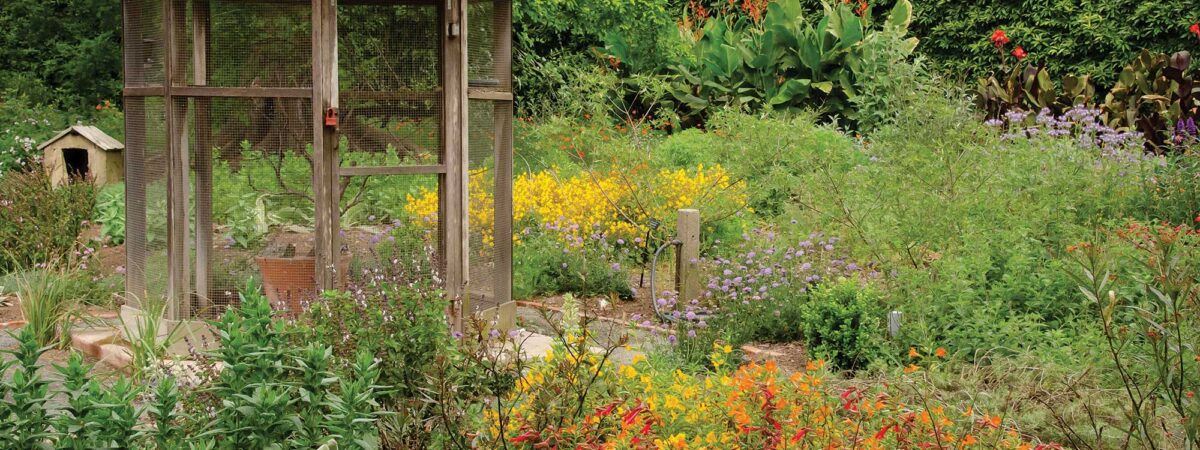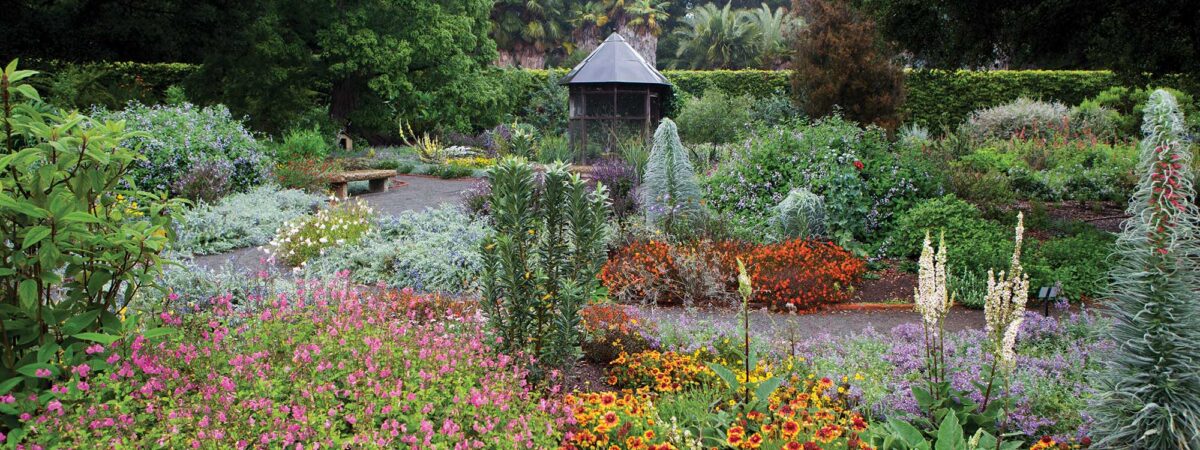The public tour season for 2024 is now closed. The Garden re-opens for public tours on February 15. We look forward to welcoming you in 2025.
Top Tips for Transitioning to Sustainable Horticulture
PARTNERING WITH NATURE
A Guide to Sustainable Horticulture
Contents
Top Tips for Transitioning to Sustainable Horticulture
Lotusland’s sustainable horticulture practices harness the power of ecology by modeling natural systems. Instead of working against natural processes, the gardener works with them. This ecologically-based approach requires respecting the garden as an ecosystem for a diversity of organisms, both above and below ground. Together, these organisms maintain a dynamic balance that supports healthy plants. The following are essential components of Lotusland’s sustainable horticulture practices that can be easily implemented in your home garden.
Ditch Synthetic Products

Synthetic products, including fertilizers, insecticides, and herbicides, cause a number of problems in the garden. Synthetic fertilizers contribute to pest problems by promoting weak, lush growth that is attractive to insects that feed on plants. These products also disrupt soil biology and decrease soil carbon, among other impacts. Insecticides harm not only target pest species, but also kill beneficial species that help manage pests naturally and many of which serve as important pollinators. Many synthetic herbicides are potentially hazardous to human health and may impact soil biology. Adopting sustainable practices makes the use of these harmful products completely unnecessary.
Tips & Tricks
- Replace synthetic fertilizers with organic, meal-based products derived from alfalfa, fish, bone, feather, or kelp.
- Eliminate the need for herbicides by pulling weeds before they go to seed and by using mulch to suppress their growth.
- Opt for organic herbicides in situations where weed control by pulling and mulching are not feasible.
- Learn to tolerate low levels of pest insects instead of responding with insecticides.
Select Plants to Create Habitat

A proper selection of plants attracts insects, birds and other wildlife, kick-starting robust ecology that benefits garden health. Plants that provide pollen and nectar draw in predatory insects (those that feed on other insects, including pests), as well as pollinator species, including butterflies, moths, and hummingbirds. These organisms are the base of the food chain – their presence brings in birds and other critters. A diverse abundance of organisms keeps populations in balance, eliminating the need for pesticides.
For the installation of new landscapes, try to plant with at least 1/3 plants native to your area, both annuals and perennials, to provide the types of pollen and nectar that native insects have evolved to survive on; 1/3 popular exotic plants that attract insects; and 1/3 favorite exotic plants regardless of their habitat potential, as the other two-thirds will provide enough habitat. This plan provides an ideal minimum amount of habitat while still leaving space for your favorite ornamentals – if you’d like to go 100% native, there’s no harm in that. Specific plant recommendations will depend on your location.
Tips & Tricks
- Select groupings of a few native plants with staggered bloom times as the base of your plant palette.
- Don’t be too tidy. Leaf litter, twigs, and debris on the ground are potential habit. It’s okay for there to be some brown in your garden.
- Attracting insects is the goal – don’t respond to their presence with insecticides.
Build Healthy Soil

Plant health is dependent on soil health. The community of organisms that live within the soil (“the soil food web”) aid in disease suppression and improve soil fertility and structure. Improved soil structure increases water infiltration and holding capacity, reducing irrigation needs. You can support soil biology by incorporating organic matter into the soil through the use of organic fertilizer, compost, compost tea, and mulch. This organic matter is food for organisms which cycle nutrients through the soil ecosystem. Keep in mind that what constitutes ideal soil conditions will vary depending on your plant selection.
Tips & Tricks
- Turn your food scraps and green waste into rich, soil-building compost. Use it directly in the garden as a soil amendment, or go a step further and experiment with making compost tea in a 5-gallon bucket.
- Ask your local arborist about wood chip delivery. Tree companies are often looking for a place to dispose of truckloads of chips each day. These chips make a great mulch for large, open areas.
- Avoid walking unnecessarily through your garden beds. Stick to paths as much as possible. Soil compaction is detrimental to soil structure and biology.
Understand Plant Needs and Garden Conditions

Plants have widely varying needs in terms of soil, nutrients, light, temperature, water, and space. A one size fits all approach to plant care won’t work. Understanding the needs of the plants in your garden is a critical step in sustainable horticulture, otherwise you will be met with poor growth, pests, and disease. Growing a plant in the wrong conditions will be an uphill battle. Learn about the conditions in your garden and select plants that are compatible with those conditions. If a plant in your garden is suffering, consider whether the growing conditions might be the cause.
Tips & Tricks
- Observe your garden throughout the seasons and in varying conditions. How does water move through the landscape after a heavy rain? How does sunlight change throughout the year? Do you have microclimates where conditions are slightly different?
- Consider soil texture in your garden. The soil texture “jar test” is a simple at-home method that will help you understand your soil texture and drainage conditions., allowing you to select appropriate plants and adjust irrigation accordingly.
- Consult local nurseries and gardeners about conditions in your area. Ask for their recommendations.
- Research the needs of plants before purchase. It is easy to impulsively select a plant based on appearance, but the continued health and beauty of that plant is dependent on your ability to meet its needs.
Commit to Sustainable Practices.

As much as your circumstances allow, go “all in” from the start. Don’t pick and choose which sustainable practices to adopt. When used together, these practices provide overlapping benefits. Ignoring any of them will result in setbacks. As your garden transitions, there will be an adjustment period during which the system works towards equilibrium. Many problems will go away, while others might temporarily get worse. Don’t panic and give into synthetic products if an issue arises. Imbalances will sort themselves out in time. The sooner that you fully adopt sustainable practices, the sooner you will see the results. Everyone has the ability to succeed in creating a sustainable garden.
Tips & Tricks
- Don’t let the size of your space or your budget deter you from beginning changes. Even if you are only able to incorporate a single wildlife-friendly plant, it’s a starting point and has an impact.
- Be patient and trust the process. Results won’t appear overnight. Keep charging forward.
- Take time to slow down, observe your garden, and appreciate the changes that are occurring.
- Encourage your friends and neighbors to adopt sustainable practices in order to magnify the impact.
